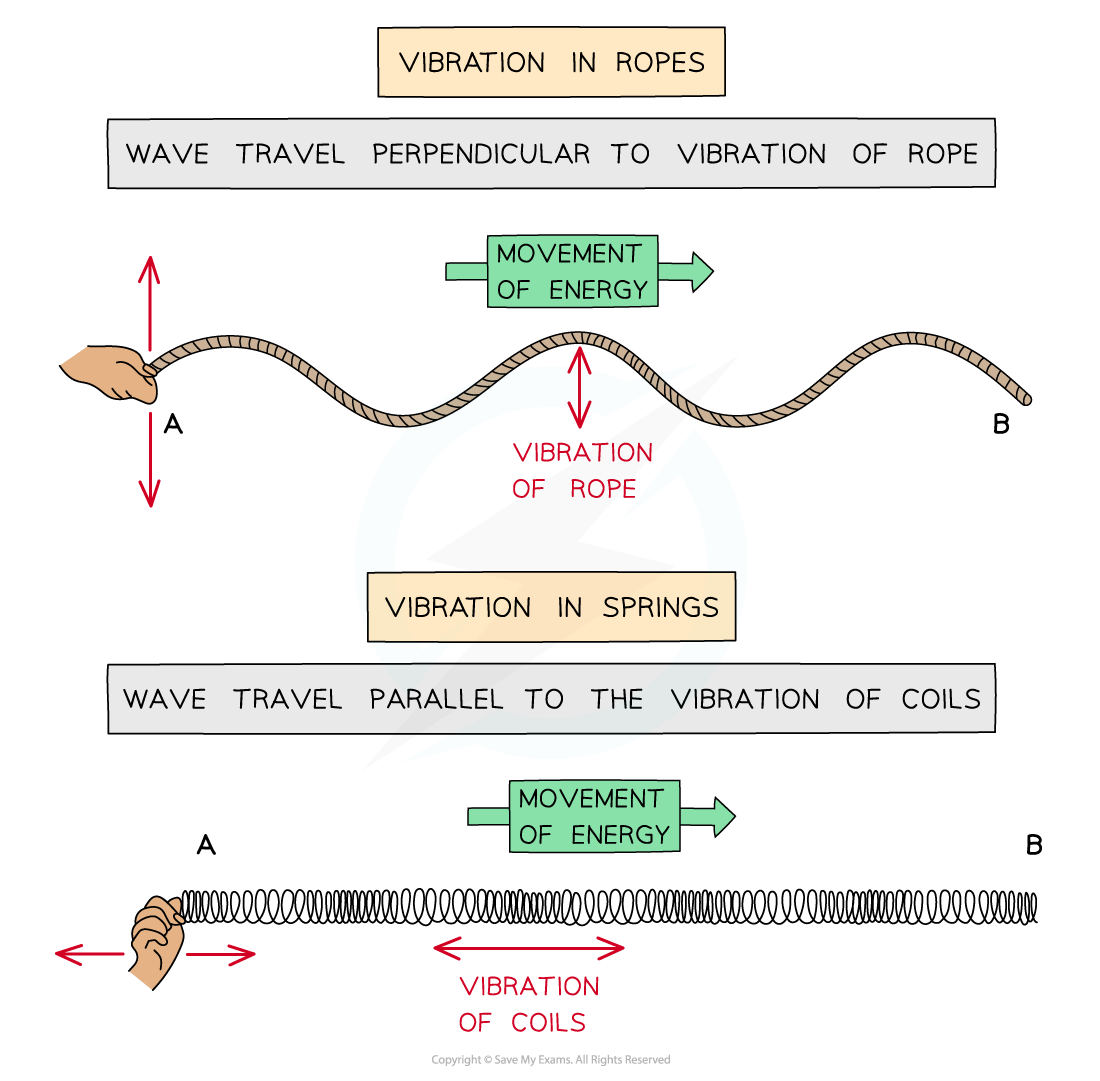Transverse & Longitudinal Waves (Edexcel IGCSE Physics (Modular)) : Revision Note
Transverse & longitudinal waves
Waves can come in one of two types:
Transverse waves
Longitudinal waves
Transverse waves
Transverse waves are defined as:
Waves that vibrate or oscillate perpendicular to the direction of energy transfer
Transverse waves:
oscillate perpendicularly to the direction of travel
transfer energy, but not the particles of the medium
exist as mechanical waves which can travel in solids and on the surfaces of liquids but not through liquids or gases
exist as electromagnetic waves which can move in solids, liquids, gases and in a vacuum
On a transverse wave:
the highest point above the rest position is called a peak, or crest
the lowest point below the rest position is called a trough
Example of a transverse wave

Transverse waves can be seen in a rope when it is moved quickly up and down
Examples of transverse waves are:
Ripples on the surface of water
Vibrations in a guitar string
S-waves (a type of seismic wave)
Electromagnetic waves (such as radio, light, X-rays etc)
Longitudinal waves
Longitudinal waves are defined as:
Waves where the points along its length vibrate parallel to the direction of energy transfer
Longitudinal waves:
Oscillate in the same direction as the direction of wave travel
Transfer energy, but not the particles of the medium
Move in solids, liquids and gases
Cannot move in a vacuum (since there are no particles)
The key features of a longitudinal wave are where the points are:
Close together, called compressions
Spaced apart, called rarefactions
Example of a longitudinal wave

Longitudinal waves can be seen in a slinky spring when it is moved quickly backwards and forwards
Examples of longitudinal waves are:
Sound waves
P-waves (a type of seismic wave)
Pressure waves caused by repeated movements in a liquid or gas
Comparing transverse & longitudinal waves
Wave vibrations can be shown on ropes (transverse) and springs (longitudinal)
A comparison of longitudinal and transverse waves

Waves can be shown through vibrations in ropes or springs
Properties of transverse and longitudinal waves
Property | Transverse Waves | Longitudinal Waves |
|---|---|---|
Structure | Peaks and troughs | Compressions and rarefactions |
Vibration | Perpendicular to the direction of energy transfer | Parallel to the direction of energy transfer |
Vacuum | Can travel in a vacuum (electromagnetic waves) | Cannot travel in a vacuum |
Material | Can travel through solids, and on the surface of liquids | Can travel through solids, liquids and gases |
Density | Constant density | Changes in density |
Pressure | Pressure is constant | Changes in pressure |
Speed of wave | Dependent on material it is travelling through (fastest in a vacuum) | Dependent on material it is travelling through (fastest in a solid) |
Worked Example
The diagram below shows a loudspeaker generating sound waves, which travel to the right as indicated. Sound waves are longitudinal. A dust mote floats in the air just next to the loudspeaker, labelled D.

Draw arrows on the diagram to indicate how the dust mote D would vibrate as sound waves pass it.
Answer:
Step 1: Recall the definition of longitudinal waves
Points along longitudinal waves vibrate parallel to the direction of energy transfer
This means the dust mote vibrates in a line parallel to the direction of the sound waves drawn
Step 2: Draw arrows at the point labelled D to show it vibrating in parallel to the direction of the sound waves

Waves & energy
Waves are disturbances caused by an oscillating source that transfer energy and information without transferring matter
Waves are described as oscillations or vibrations about a fixed point
For example, ripples cause particles of water to oscillate up and down
Sound waves cause particles of air to vibrate back and forth
Evidence that waves transfer energy and not matter

Waves transfer energy and information, but not matter. This toy duck bobs up and down as water waves pass underneath
The wave on the surface of a body of water is a transverse wave
The duck moves perpendicular to the direction of the wave
The duck moves up and down but does not travel with the wave
Examiner Tips and Tricks
Exam questions may ask you to describe waves and this is most easily done by drawing a diagram of the wave and then describing the parts of the wave - a good, clearly labelled diagram can earn you full marks!
You may also be asked to give further examples of transverse or longitudinal waves - so memorise the lists given here!

You've read 0 of your 5 free revision notes this week
Sign up now. It’s free!
Did this page help you?

